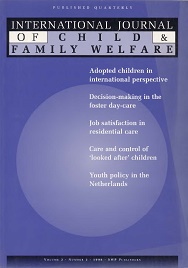Manners in youth policy. Three decades of youth policy in the Netherlands
Abstract
The hand that rocks the cradle rules the world. This saying is as well-known as it is ambivalent. Neither the societal position of young people nor the public attention they have received since the 16th century have remained constant in the course of time. In this article we will identify some trends in recent Dutch youth policy, with particular emphasis on the last 30 years. The shifts can be summarised by the statement that youth policy developed from a limited policy in the late 1960s with huge aspirations for the future - and oriented towards a very broad target group, namely young people in general - to a highly intensified, inter-sectoral and comprehensive policy, characterised by moderate pretensions and focused on a limited group of youngsters-at-risk, in the mid-nineties. What are the ‘manners’ to be taught, and how is this being done today? In the first phase: young people have to participate; in the second: young people have to work; in the 1990s: young people have to behave. Our conclusion is that youth policy is highly susceptible to epoch-related fluctuations. Both ‘young people’ and ‘youth policy’ are flexible concepts. Prior to the interpretation of three main planks of governmental youth policy (1969, 1984 and 1994), we will provide some brief historical outlines.

